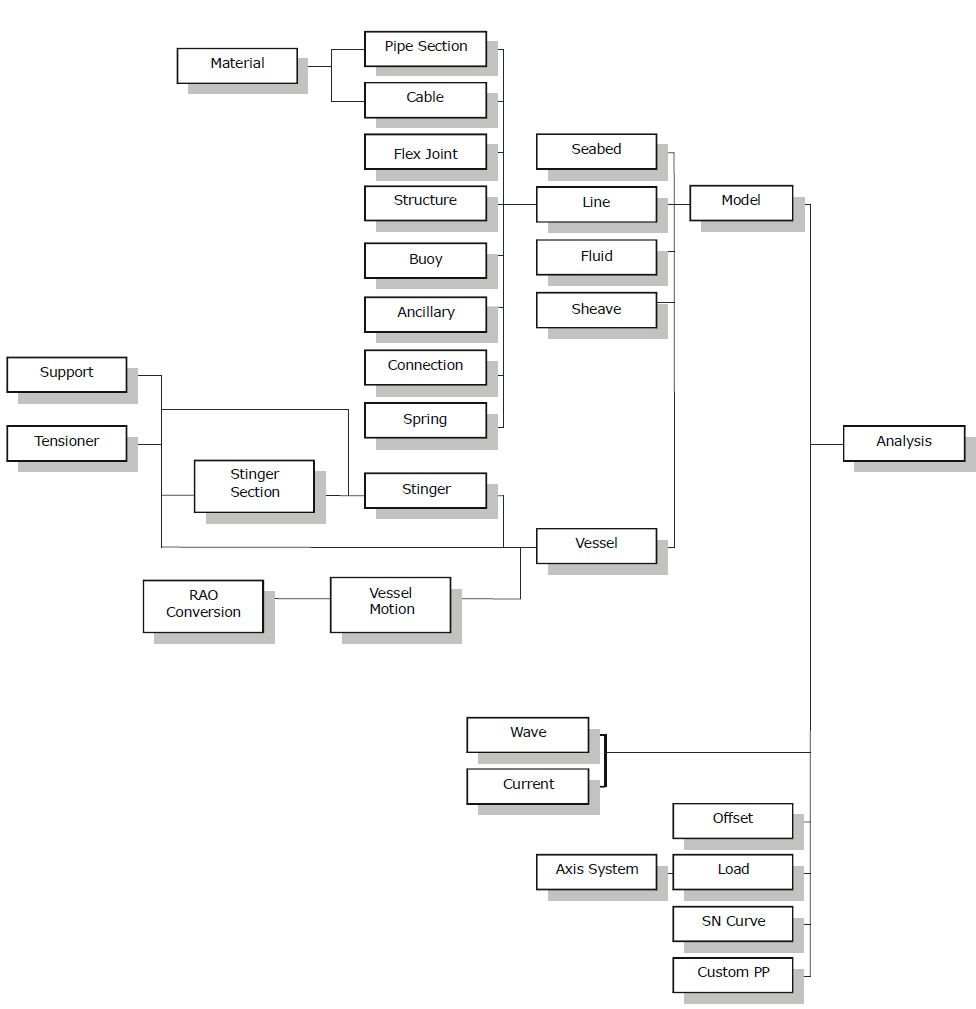The basic concepts which underpin the operation of the PipeLay GUI are described in the following sections:
•‘Components and Project Files’ explains how PipeLay organises data into modular units known as components.
•‘Component List’ lists all the various components which are available in PipeLay.
Two basic concepts underlie the PipeLay GUI design, namely the use of components and the storing of data in a project file. This section elaborates on these concepts.
PipeLay models are composed of building blocks known as components. Components are used to store all project data, including pipeline data, vessel data, environmental data, analysis data and so on.
Components are designed to be as modular as possible, and higher-level components generally reference lower-level ones. For example, a single Material component representing steel may be referenced in the definition of several Pipe Section and Cable components.The figure below shows the hierarchy of components in PipeLay.

Component Hierarchy
You store the PipeLay components you define in a project file. A project file is intended to store all the information relevant to a single project. You can define as many different components as you want, representing different pipelines, different environmental and loading conditions, alternative stinger configurations, different types of analysis, and so on, and store them all in one file. When running an analysis, it’s simply a matter of selecting the components that you wish to include in that analysis.
You can readily copy and paste components (or whole groups of components) from one project file to another, so you don’t have to keep inputting the same data again and again. You can multi select components by clicking on the parent folder and then selecting components in the Component View Area. You can also drop a component on PipeLay Project component in order to place it in the root level of the Project Sidebar.
The full list of the components available in PipeLay and the corresponding Insert tab icons is presented in the table below, which is sorted based on the group or ribbon menu in which the components are located. Note that the Support and Tensioner components appear in both the Stinger and Vessel ribbon menus so the components are shown twice in the table in the interest of clarity.
The Project component is unique in that, unlike the other components, it is created automatically by default, rather than being created by the user, and there can only ever be one. It is the top-level component in all PipeLay projects, and is used to store general project information, such as global constants, units-system choice, and so on.
Table: Component List
Group / Ribbon Menu |
Icon |
Component |
Fundamental |
|
|
Base |
|
|
Line |
|
|
|
||
|
||
|
||
|
||
|
||
|
||
|
||
|
||
Stinger |
|
|
|
||
|
||
|
||
Vessel |
|
|
|
||
|
||
|
||
|
||
|
||
Model |
|
|
|
||
|
||
|
||
|
||
Load |
|
|
|
||
|
||
|
||
Fatigue |
|
|
Postprocessing |
|
|
Analysis |
|
|
|